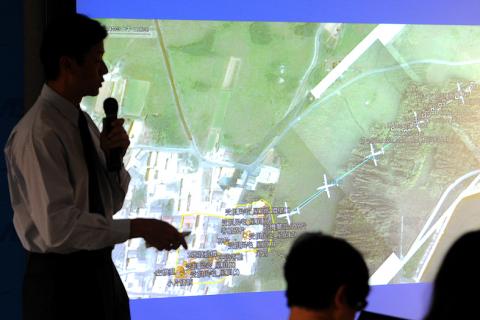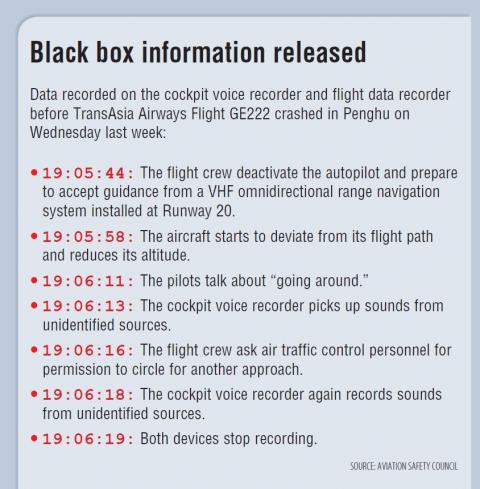TransAsia Airways (復興航空) Flight GE222 had deviated from its flight path before crashing near Magong Airport in Penghu on Wednesday last week, the Aviation Safety Council (ASC) said yesterday, adding that it crashed eight seconds after the pilots considered “going around” for another approach.
The council presented the results of its preliminary investigation yesterday after listening to the plane’s cockpit voice recorder (CVR) and flight data recorder (FDR).
Council executive director Thomas Wang (王興中) said the wreckage of the aircraft was found in the forest and some houses outside Magong Airport.

Photo: Liao Chen-hui, Taipei Times
Wang said the flight crew had deactivated the autopilot system about two minutes after it was given permission at 7:03pm to land on Runway 20.
However, the aircraft started deviating from its flight path and dropped altitude. The flight crew then talked about the possibility of going around, according to the black box recordings, Wang said.
While Magong Airport requires landing aircraft to approach the runway at 201 degrees, the recordings showed that the plane had shifted to 188 degrees, Wang said.

Investigators found that the speed of the left engine (Engine No. 1) had decelerated at 7:06:13, only two seconds after the two pilots talked about going around.
At the same time, the CVR recorded sounds from unidentified sources, which investigators said could be noises made when the plane flew into the forest. When the investigators found the engine at the crash site, they discovered that the engine’s intake valve was filled with tree branches.
According to the engine’s manufacturer, Pratt & Whitney Canada, the tree branches could have hindered the engine’s ability to generate power, Wang said.
To complete the going around, an aircraft must accelerate.
The CVR also showed that the pilots asked the air traffic personnel’s permission to go around, which was again followed by recordings of indistinguishable sounds.
In terms of weather conditions, Wang said the FDR showed that the wind speed did not change much — varying between 40 and 50 nautical miles (74 to 93km) when the aircraft tried to approach the runway.
Wang said the pilots talked about the weather conditions twice. The first time was before they talked about switching from Runway 20 to Runway 02. The second time was when they asked to land at Runway 20 again, in which they noted that “the wind was very strong.”
“The pilots did not express verbally that there was an emergency situation,” Wang said.
Wang added that the investigators did not hear from the CVR the pilots saying “No way,” as some media reports had said.
Conversations transcribed from the black boxes also showed that the pilots requested to switch from Runway 20 to Runway 02 twice after they were informed that visibility at the airport was only 800m.
However, they requested to land on Runway 20 after they were told that visibility had improved to 1,600m and another ATR aircraft owned by Uni Air (立榮航空) had secured permission to land on Runway 20.
According to the Civil Aeronautics Administration, there was a strong southwesterly wind blowing on Penghu that day because of Typhoon Matmo. As aircraft need to land or take off against the wind’s direction, all the planes arriving in Penghu that day were to land on Runway 20.
Magong Airport’s Runway 02 is equipped with an instrument landing system, which requires a minimum visibility of 800m. However, aircraft landing on Runway 20 need to follow the guidance of an VHR omnidirectional range (VOR) navigation system, which requires a visibilility of 1,600m.
The council’s report still left many questions unanswered, such as whether the engine decelerated because of engine failure or because of the tree branches that were sucked into the engine.
Investigators also need to determine why the plane deviated from its course, as the VOR was found to be functioning normally at the time, and why the plane changed altitude drastically after the pilots talked about going around.
Wang said the council is scheduled to submit a preliminary report of the investigation to the Executive Yuan and International Civil Aviation Organization before the end of this month.

The CIA has a message for Chinese government officials worried about their place in Chinese President Xi Jinping’s (習近平) government: Come work with us. The agency released two Mandarin-language videos on social media on Thursday inviting disgruntled officials to contact the CIA. The recruitment videos posted on YouTube and X racked up more than 5 million views combined in their first day. The outreach comes as CIA Director John Ratcliffe has vowed to boost the agency’s use of intelligence from human sources and its focus on China, which has recently targeted US officials with its own espionage operations. The videos are “aimed at

STEADFAST FRIEND: The bills encourage increased Taiwan-US engagement and address China’s distortion of UN Resolution 2758 to isolate Taiwan internationally The Presidential Office yesterday thanked the US House of Representatives for unanimously passing two Taiwan-related bills highlighting its solid support for Taiwan’s democracy and global participation, and for deepening bilateral relations. One of the bills, the Taiwan Assurance Implementation Act, requires the US Department of State to periodically review its guidelines for engagement with Taiwan, and report to the US Congress on the guidelines and plans to lift self-imposed limitations on US-Taiwan engagement. The other bill is the Taiwan International Solidarity Act, which clarifies that UN Resolution 2758 does not address the issue of the representation of Taiwan or its people in

US Indo-Pacific Commander Admiral Samuel Paparo on Friday expressed concern over the rate at which China is diversifying its military exercises, the Financial Times (FT) reported on Saturday. “The rates of change on the depth and breadth of their exercises is the one non-linear effect that I’ve seen in the last year that wakes me up at night or keeps me up at night,” Paparo was quoted by FT as saying while attending the annual Sedona Forum at the McCain Institute in Arizona. Paparo also expressed concern over the speed with which China was expanding its military. While the US

SHIFT: Taiwan’s better-than-expected first-quarter GDP and signs of weakness in the US have driven global capital back to emerging markets, the central bank head said The central bank yesterday blamed market speculation for the steep rise in the local currency, and urged exporters and financial institutions to stay calm and stop panic sell-offs to avoid hurting their own profitability. The nation’s top monetary policymaker said that it would step in, if necessary, to maintain order and stability in the foreign exchange market. The remarks came as the NT dollar yesterday closed up NT$0.919 to NT$30.145 against the US dollar in Taipei trading, after rising as high as NT$29.59 in intraday trading. The local currency has surged 5.85 percent against the greenback over the past two sessions, central